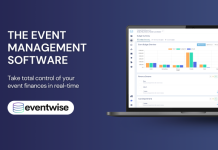Darren Gallop is the CEO of Marcato, an innovative Canadian company that specialises in the creation and development of web-based management solutions designed to maximise efficiency in the festival & entertainment industry. Their two flagship applications, Marcato Festival & Marcato Enterprise, are now being used to manage organisations worldwide, by over 2000 users, including festivals like Coachella, Hard Fest, Osheaga, CMA Fest, Iceland Airwaves, Eurosonic Noorderslag; and events like the Country Music Association Awards, the Commonwealth Games, Pride Toronto, and many more.
As Teresa Moore mentioned in a recent Insider Insights article, the festival industry is now professionalising at an intense rate and the need for specialised technology and staff has never been greater.
Festivalgoers’ growing expectations have raised the bar in terms of what’s required to stage a worldclass festival. Because of this shift, festival organisers are now being forced to resort to specialised technologies to assist them in their task, and the marketplace has become crowded with competing solutions and new services, each bragging about their own unique advantages.
As a festival planner, selecting and managing technology for your festival can be one of the most painstaking things you’ve ever been tasked with if you go into the situation blind.
The purpose of this article is to act as a guide for selecting and managing your festival’s technology providers. It includes a detailed look into the following four areas:
● The decision to buy and why.
● A few tips on picking the best provider out there.
● How to implement your new technology.
● Tips on the long-term management of your technology including a quick spotlight on when you should be thinking of jumping ship vs. staying put.
The Decision to Buy & Why:
Before you can move forward with exploring all of the of technology options out there, there are a few major questions you’ll need to answer first, including:
● What are your short, medium and longterm goals?
● Who are the key people you want involved and what are their roles in the decision making process?
● As a team, what are you trying to accomplish?
● What pains or challenges do you want to address with technology?
● Are there organisational pains or challenges that take a higher priority than others?
● What are the specific things you want to be able to do once a solution is implemented?
● How open is your entire team when it comes to adopting new technology?
● How techsavvy are your team members? Will they require additional training and support?
● Finally, what is your timeline for the process, and does it take into consideration the planning cycle for your event?
The questions above are key. Before contacting providers or partners, before reading through materials, and especially before you view any demonstrations, you must be concise and certain on all of the above questions and be able to clearly articulate them to both your team and the providers you’re about to engage with.
Once you’ve articulated your key goals and needs properly, your next step will be to identify all the options and avenues that might be available to solve them. You can research these using three methods:
1. Connect to a good network of festival professionals: Festival Insights can be a great resource when connecting to a network of festival pros. You can also find other groups online that have become a sort of ‘hub’ for festival professionals, via social media sites like LinkedIn or Facebook. Personally, I find the best way to connect to a great festival network is by attending professional conferences like the UK Festival Awards & Conference, or other international festival conferences like Eurosonic Noorderslag, IMFCON, or Reeperbahn. Once you’re connected to these networks, get talking! Ask your peers how they are addressing the problems you are looking to solve. Collect their responses and weigh them against the success of the events they produce.
2. Talk to your friends: If you’re lucky (and you’ve worked in the festival industry for a little while now), you’ve most likely started to collect a small group of friends who also produce festivals. These people will often give you more passionate feedback, claiming that they hate this service provider, while they love another, while festival network contacts will attempt to be a little more bipartisan with their approach. However, each opinion is equally important to consider because, when combined, they not only speak to the features and functionality of a service and its provider, but also how those providers treat their clients.
3. The last method is rather obvious, but it shouldn’t go without saying…google like you’ve never googled before: There are some great resources out there, including blogs, case studies, comparisons, white papers, and anything else you can get your hands on. These types of resources can be extremely helpful when trying to wrap your head around the space you’re exploring. Dive in! Educate yourself as much as possible. This will go a long way when you’re in conversations with providers.
Make a running list of all the options you wish to seriously inquire about, noting your favourite points about each as well as any negative feedback you have.
As a side note: if a service provider you really like seems to do everything you need them to, but they’re just missing one key component, speak to someone on their team. Tech companies move a mile a minute and they just might be already offering the service you’re looking for in beta, but haven’t officially announced it yet.
A Few Tips on Picking the Best Provider:
When picking a provider look at the company, not just the product. Obviously, it’s key the product is a fit, but it’s also equally as important to ask questions like:
● What is the company’s support like?
● Does the company work with clients similar to you?
● What are the longterm goals of the company?
Learn about them. Are they the latest flash in the pan, or have they been around for a while? Is the company here to stay, or are they just trying to take advantage of a fad? New startups can be exciting and energetic, but you need to ask yourself if they have enough manpower and scope to be able to take on your current needs, as well as maintain a strong service offering for you over the next five years. Many new companies can have a great start, but then quickly bottom out before they can really prove their worth to the market.
One way you can do this is by looking at the company’s growth; look at what they’ve put out over the last 24 months and see if they’ve announced any future projects. Doing this will give you a much better impression of how fast things are moving at the company and if they’re invested in their service offering. It’s very important to hire a tech provider that is going to grow with you and mirror the pace you’re moving at.
When you’re working through this process, talk to more than one company. I know it takes a ton of time, but just think of how much you are going to be using this technology. Investing this time upfront could save you and your team hours of future frustration and grief.
Another way to vet a provider is to see how easy it is to form a relationship with them. When implementing important technology (and managing it longterm), the relationship you have with your vendor is paramount. The support they can offer you in these times can make a world of difference. For example, as the CEO of a company that delivers specialised management software to festivals, I know that my product offering has to be topnotch; the technology we use has to be the most advanced, the functionalities we offer must be the most robust, and we must always remain at the top of our game. However, if we’re able to maintain all of these great things, but our customer support and relationships aren’t outstanding, it will all be for nothing. That is why my staff and I are so careful about the way we treat our clients, because we understand our support is just as important as any functionality we provide.
This leads me to my last point on picking a provider: when all is said and done, try not to get caught up in ‘feature comparison charts’ (they are almost always inaccurate and biased) instead just look for the solution that solves the most critical problems for you and don’t get caught up in all the other bells and whistles.
The Implementation:
Once your decision is made and you’re confident about it, your next step will be implementing the tech. Here are a few things to keep in mind before you cut a cheque:
● Make sure all your deliverables and timelines are written down, with careful consideration and great articulation. You may have already developed this kind of documentation internally, but now it’s time to knock it up a notch! Deliver it to your provider and make sure your expectations are very clear before you move forward.
● It’s also very important to put someone on your team in charge of the entire implementation. This individual doesn’t have to be to be a wizard at technology, but they should have a certain amount of technical knowhow in order to be able to track deliverables as they come in, checking them off as they do. It’s also very helpful to have that same staff member become the point person for all future dealings with the service provider. Therefore, if issues or problems do arise, that person is already very familiar with the platform and they’ll be able to clearly articulate the problem.
● Do your own quality assurance! Thoroughly test things before they are needed. I understand it takes a lot of commitment to actually test technology, for real. I also understand how it’s very tempting to glance over a deliverable, rather than running it through the ringer to find any fixes that might need to be made. You just can’t assume your service provider did enough testing for a perfect production day they most likely have no idea what that should look like and, therefore, they can’t accurately test for it. This has nothing to do with your provider being thorough or not, and everything to do with what you consider ‘functional.’ So, when testing your technology, test it in a way that most closely reflects the reallife use case of what is going to be required of it for a perfect production day. And don’t test things the day before your event. Think weeks, not days.
Long-Term Management:
When it comes to the longterm management of a service provider, there are usually only two things that bring up a need for reevaluation: one, the provider is dropping the ball on some very important projects, or two, they are no longer providing all the services you need to move forward as an organisation. Each question leads you back to the ultimate adage of ‘you gotta know when to hold’em and know when to fold’em.’
So, how do you know?
First, when addressing major issues with a company, or if you’ve already told them you’re considering a switch, keep in mind future iterations and product updates are very challenging for companies to calculate. Once you’ve articulated the problem, it’s critical the company gives you real information to work with and evaluate from don’t let them feed you false information. You can’t truly evaluate a situation until you have the whole truth.
Furthermore, when approaching a company with a potential pinkslip, always clearly articulate your concern, but engage in honest, respectful conversations about your challenges. Demand your providers give you realistic answers about whether they can move forward with you, but don’t make a huge decision like that without a lot of thought. Sometimes the grass really can look greener on the other side of the fence. If you can, talk to friends who are using your provider’s competition and see if things really are any better over there.
After collecting all of that information, if you’re still unhappy, it might be time to consider cutting your losses.
In Conclusion:
As I mentioned in the introduction of this guide, the festival industry is truly coming into it’s own as a professionalised space. As a result of this shift, the marketplace has become crowded with fresh new faces and some very green ideas. Therefore, it has never been more important to carefully choose who you are going to partner with, as it truly could mean the difference between a successful or unsuccessful event! Good luck!





